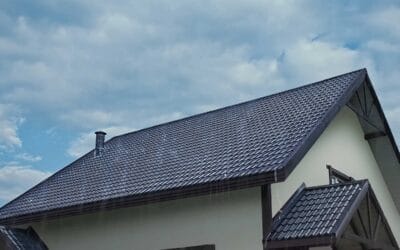Many people automatically think of shingles and gutters when they think of a roof. They tend to generally be unaware that there is usually another coating of protection between just the shingle layer and your roof rack that plays a crucial role in the prevention of moisture damage in your home. It is known as roofing underlayment and is a very important part of your roofing system.
Through your research, you will find two common types of flooring used for roofing. But the million-dollar question is, which is better?
What is Roofing Underlayment?
The roof underlayment is the roofing material in between your roof and your shingles. It is installed on your roof deck and provides additional protection against objects.
Under-roof installation is integrated into the roof, usually plywood or OSB (Oriented Strand Board) and shingles. The deck of the roof is installed, and the underlayment goes directly over it. It’s main purpose is to provide an extra form of protection against all the elements your roof is exposed to whether that’s wind, rain, snow, snow. Anything the sky can throw at you.
There are two different types of underlayment: synthetic and felt.
Felt Roofing Underlayment
Felt underlayment is a natural roofing material (natural woods, natural fibers, etc.) or a synthetic base (polyester or fiberglass) that is filled with asphalt to prevent waterproofing. It is then laid down on the roof deck and attached to that area under the roofing material.
Felt was widely used in the late 1900s as a preferred method of laying down but is slowly disappearing due to the development of new and improved products (synthetics). However, it is still used today in the area of slopes and shingle systems.
Benefits of Felt Underlayment
The cost is the main selling point for felt underlayment. It’s way more budget-friendly than other alternatives, so if low maintenance costs are a big part of your foundation, this is your best option. While it may be beneficial for some homeowners to purchase a custom-made item, it may not be necessary or unimportant for others. So, if you have a tight budget, feeling less is the best decision you can make. However, as we have already mentioned, you may need to purchase several audio rolls for a single project, as opposed to a single volume roll for the same project.
Furthermore, felt tends to be more breathable. An audible underlay, while resistant to water, is still breathing. This is an important addition to your roofing material, especially asphalt shingles. As the roof made from plywood can breathe, it contributes to the longevity of your shingles.
Drawbacks of Felt Underlayment
While their low cost is a benefit, being placed under a reasonable roof comes with many disadvantages. The main disadvantage of soundproof coating is that it can not be exposed to objects for more than a few hours without drying and aging, greatly reducing its effectiveness by protecting moisture.
⦁ Felt cannot be left exposed to objects at any time, so installing roofing materials is recommended as soon as possible after the feeling has subsided. Failure to do so may result in a leak in the roof.
⦁ It has a higher penetration than synthetics, meaning that air and water can pass things easily
⦁ it does not respond well to sweltering climates as it is particularly vulnerable to high temperatures that break down property, dry out oil, crack, and ultimately damage prematurely.
⦁ It absorbs water and can shrink and bind easily (especially if installation lasts a long time), making it almost impossible for shingles to lie on the ground.
⦁ Felt underlayment weights over performance, making it very difficult to install
⦁ A slippery surface, which makes installation very difficult
⦁ It tends to be very slippery which can pose a challenge for the ones installing it
Synthetic Roofing Underlayment
Synthetic underlayment is a roofing material created by weaving/weaving together polypropylene or polyethylene along with polymer to form a layer of protection to barricade it to place in between the roofing material and the roof. Synthetic underlayment is a new invention that takes the metal roofing industry as the best, most advanced form of sound replacement. Most synthetic underlayer is mechanically placed together with roofing caps and basic materials, while others have glue bases. Synthetic or man-made roofing is very generally very expensive, but the installation process is pretty simple and easy.
Benefits of Synthetic Roofing
⦁ Sub-placement will last longer compared to placement under the sturdy paper. In fact, many manufacturers guarantee that it will last as long as your steel roof system (40+ years), if not more.
⦁ It takes a lot to tear synthetic roofing down. This is good because it means you are less likely to damage what you put in while you are walking on it. It will last longer in weather conditions where it is exposed to ultraviolet or moisture for a prolonged period of time.
⦁ Because there is more to each roll than it sounds (the underground roof comes in wide and long rolls), your roof will make a few trips up the ladder, save time and maybe speed up work as it only needs a few trips between the ground and the roof to get new trucks.
⦁ Most synthetic underlayer has a slippery surface. Your installer can walk the roof with more confidence, not having to worry too much about slipping.
⦁ In contrast to sensitivity, synthetic underlayment is generally resistant to mold growth because it is made of plastic. Synthetic underlayer is designed to resist water while soundproof materials absorb it.
The surface of most of the roofing materials, including those offered by Roofing Companies in OKC, and Edmond provides a wide range of sliding and sloping areas for better mobility. It is usually well marked with cross-sectional guidelines and indications of where the commitments should go, which helps consistently and accurately during installation.
Another thing to look for whilst selecting a synthetic underlayment is who is producing it and whether your contractor is trusted and respected or not. Unfortunately, the Oklahoma City Roofing underlayer industry is not entirely standardized. This means there are no small guarantees of quality and performance.
Drawbacks of Synthetic Roofing
The worst thing about under coverage is that it often comes at a high price. Depending on the manufacturer or where it is purchased, synthetic materials may cost two to five times as much as plain paper. As it is one of the most effective tools you can use as a subset and the fact that it is newly developed, you get what you pay for (high quality, long-lasting product). Also, bear in mind that synthetic underlayment for roofs comes in large quantities, so you may need to purchase a plethora of paper towels to cover the roof structure, which may even result in balancing any price difference in the end. However, making an investment in high-quality roofing can save you a lot of money in the long run. You can’t put a premium on the serenity of the mind that comes with knowledge that your roof is well protected from damage and moisture.
Sub-placement will be more expensive compared to sound. So if your previous expenses are an issue, this could be a major issue. However, if you are very interested in long-term investments and plan to be at home for many years and make it your dream home then an initial hefty cost can pay off right away.
Moreover, although it may be a good idea that the lower part of the roof has a lower penetration rate, which means less water and air can pass through it, it can also cause problems if not installed correctly. With artificial insulation, moisture from the inside of the building cannot get out of the outside, which means that proper attic and ventilation of the building is essential when installing synthetics.
Conclusion
Choosing between a felt or synthetic underlayment may be another homeowner’s option. However, like many other things, it is an integral part of the roofing process that will affect the longevity of your roof.
Having a budget idea is essential when it comes to roof changes. But make sure you take all the factors into account when making the final choice for your roofing material.It sounds like the felt underlayment is famous for its low cost. However, it tends to rip and tear during installation and weather events, exposing your roof. In addition, moisture can cause the sensor to shrink and the shingles not to settle. Also, it is difficult to handle because of its increased weight and slippery nature. Lastly, some roofing coatings do not include roofing unless they have synthetic underlayment.
While Felt roofing’s low cost is a benefit, being placed under a reasonable roof comes with many disadvantages. Synthetic roofing has a plethora of advantages over felt and can be an essential investment in the protection of your roof and house from potential damage like from water and moisture infiltration.
Contact a roofing specialist to learn the best way to put under your items. If you have questions, would like a project rating or you are looking for high-quality roof repairs, there are many roofing companies in Edmond and roof repair in Norman, Okc that have professionals that can get the job done.




